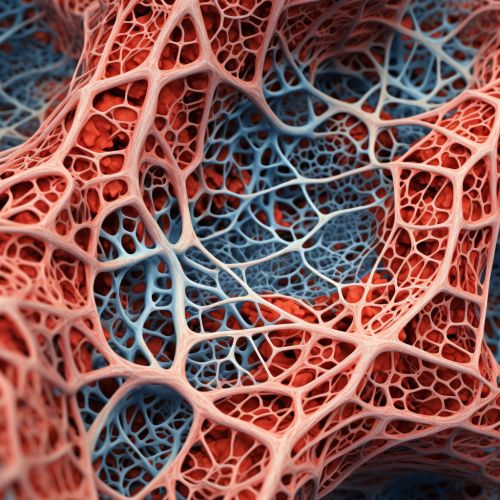Gas exchange
Overview
Gas exchange is the biological process that allows for the passage of gases between an organism and its environment. This process is crucial for life as it enables the intake of oxygen from the environment and the release of carbon dioxide produced by cellular respiration. Gas exchange occurs in the respiratory system of animals, the leaves of plants, and the skin of certain small animals like earthworms and amphibians.
Mechanism of Gas Exchange
The mechanism of gas exchange involves the movement of gases from an area of high concentration to an area of low concentration. This process, known as diffusion, is driven by the concentration gradient of the gases involved. In the case of animals, oxygen is taken from the environment where it is in high concentration and transported to cells where its concentration is low. Conversely, carbon dioxide produced by cells is transported to the environment where its concentration is lower.
In Animals
In animals, gas exchange occurs primarily in the lungs through a process known as respiration. The lungs are filled with millions of tiny air sacs called alveoli, which are surrounded by a network of capillaries. Oxygen from the inhaled air diffuses across the thin walls of the alveoli and into the bloodstream, where it binds to hemoglobin in red blood cells and is transported to cells throughout the body. At the same time, carbon dioxide, a waste product of cellular respiration, diffuses from the blood into the alveoli and is exhaled.


In Plants
In plants, gas exchange occurs in the leaves through tiny pores called stomata. Carbon dioxide from the environment diffuses into the leaf through the stomata and is used in photosynthesis to produce glucose and oxygen. The oxygen produced is then released back into the environment through the same stomata. This process of gas exchange in plants is closely tied to the process of photosynthesis, and the two are often studied together in the field of plant physiology.
Factors Affecting Gas Exchange
Several factors can affect the rate and efficiency of gas exchange. These include the concentration gradient of the gases involved, the surface area available for gas exchange, the thickness of the exchange surface, and the partial pressure of the gases. In addition, certain physiological and environmental factors can also affect gas exchange. These include the metabolic rate of the organism, the temperature and humidity of the environment, and the presence of certain chemicals or pollutants.
Concentration Gradient
The concentration gradient of the gases involved is a major factor affecting the rate of gas exchange. The greater the difference in concentration between the two areas, the faster the rate of diffusion. This is why animals and plants must continuously take in oxygen and release carbon dioxide to maintain a high concentration gradient and ensure efficient gas exchange.
Surface Area
The surface area available for gas exchange also plays a crucial role. The larger the surface area, the more gas can be exchanged at any given time. This is why the lungs and leaves have structures like alveoli and stomata, which greatly increase their surface area and enhance gas exchange.
Thickness of the Exchange Surface
The thickness of the exchange surface can also affect the rate of gas exchange. The thinner the surface, the faster the rate of diffusion. This is why the walls of the alveoli and the leaf cells are very thin, allowing for efficient gas exchange.
Partial Pressure
The partial pressure of the gases is another important factor. The higher the partial pressure of a gas, the more of it will dissolve in a liquid (like blood), and the faster it will diffuse. This is why high altitudes, where the partial pressure of oxygen is lower, can make breathing more difficult.
Disorders of Gas Exchange
Disorders of gas exchange can lead to serious health problems. These disorders can be caused by a variety of factors, including lung diseases, heart diseases, and environmental factors.
Lung Diseases
Certain lung diseases, such as chronic obstructive pulmonary disease (COPD) and pulmonary fibrosis, can impair gas exchange by damaging the alveoli and reducing the surface area available for gas exchange. This can lead to a decrease in oxygen levels in the blood and an increase in carbon dioxide levels, resulting in symptoms such as shortness of breath and fatigue.
Heart Diseases
Heart diseases, such as heart failure, can also affect gas exchange. In heart failure, the heart is unable to pump enough blood to the lungs, resulting in a decrease in the amount of oxygen that can be taken up and an increase in the amount of carbon dioxide that can be removed. This can lead to similar symptoms as lung diseases, as well as additional symptoms such as swelling in the legs and abdomen.
Environmental Factors
Environmental factors, such as air pollution and smoking, can also impair gas exchange. These factors can damage the lungs and reduce their ability to exchange gases, leading to a decrease in oxygen levels in the blood and an increase in carbon dioxide levels. Long-term exposure to these factors can lead to chronic lung diseases like COPD and lung cancer.
